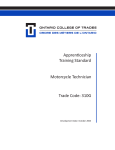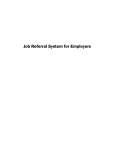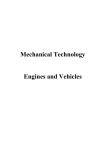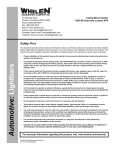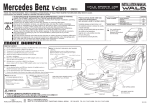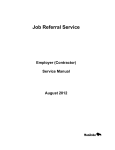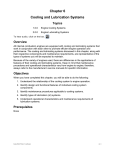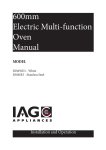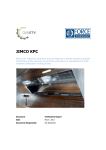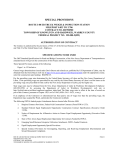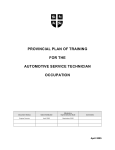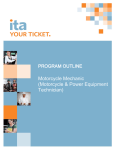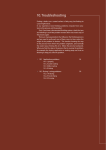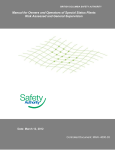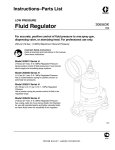Download Automotive Glass Technician - ITA BC
Transcript
PROGRAM OUTLINE Automotive Glass Technician To order additional copies please contact: Government Publications Services PO Box 9452 Stn Prov Govt Victoria, BC V8W 9V7 Phone: 250 387-6409 or Toll Free: 1 800 663-6105 Fax: 250 387-1120 www.publications.gov.bc.ca Copyright © 2008 Industry Training Authority This publication may not be reproduced in any form without permission by the Industry Training Authority Contact Director, Government Publications Services, Queen’s Printer at 250 356-6876 AUTOMOTIVE GLASS TECHNICIAN PROGRAM OUTLINE 2009 Developed By Industry Training Authority Province of British Columbia TABLE OF CONTENTS Foreword II Acknowledgements III Section 1 - Occupational Analysis Chart 1 Section 2 - Automotive Glass Technician Program Outline 4 Section 3 - Training Provider Standards Tools And Equipment Instructor Requirements Facility Requirements Suggested Texts Additional Texts Automotive Glass Technician • Industry Training Authority 36 37 39 40 41 41 i FOREWORD The revised Glass Technician Program Outline is intended as a guide for instructors, apprentices, and employers of apprentices, as well as for the use of industry organizations, regulatory bodies, and provincial and federal governments. It reflects updated standards based on the National Occupational Analysis for Glass Technician and British Columbia industry and instructor subject matter experts. Practical instruction by demonstration and student participation should be integrated with classroom sessions. Safe working practices, even though not always specified in each operation or topic, are implied part of the program and should be stressed throughout the apprenticeship. The Program Outline was prepared with the advice and assistance of the Industry Steering Committee and will form the basis for further updates of the British Columbia Glass Technician Program and creation of the learning resources by the Automotive Training Standards Organization on behalf of the Industry Training Authority. Each competency is to be evaluated through the use of written and/or a practical assessment in which the learner must achieve a minimum of 70% in order to receive a passing grade for that competency. The types of questions used on these exams must reflect the cognitive level indicated by the learning objectives and the learning tasks listed in the related competencies. Achievement Criteria are included for those competencies that require a practical component. The intent of including Achievement Criteria in this Program Outline is to ensure consistency in the training across the many training institutes in British Columbia. Their purpose is to reinforce the theory and to provide a mechanism for evaluation of the learner’s ability to apply the theory to practice. It is important that these performances be observable and measureable and that they reflect the skills spelled out in the competency as those required of a competent journeyperson. The conditions under which these performances will be observed and measured must be clear to the learner as well as the criteria by which the learner will be evaluated. The expectation for success must also be outlined for the learner. The performance spelled out in the Achievement Criteria is suggested performance and is not meant to stifle flexibility of delivery. Training providers are welcome to substitute other practical performances that measure similar skills and attainment of the competency. Multiple performances may also be used to replace individual performances where appropriate. Evaluation At the completion of technical training each apprentice will complete an evaluation examination based on that year's work. The apprentice must achieve a minimum of 70% to receive certification. SAFETY ADVISORY Be advised that references to the WorkSafe BC safety regulations contained within these materials do not/may not reflect the most recent Occupational Health and Safety Regulation (the current Standards and Regulation in BC can be obtained on the following website: http://www.worksafebc.com. Please note that it is always the responsibility of any person using these materials to inform him/herself about the Occupational Health and Safety Regulation pertaining to his/her work. Automotive Glass Technician • Industry Training Authority ii ACKNOWLEDGEMENTS The Program Outline was prepared with the advice and direction of an industry steering committee convened initially by the Automotive Training Standards Organization. Industry Representatives: Gord Hemrich Terry Hislop Tim Owens Automotive Training Standards Organization: Lloyd Stamm Kevin Cudmore Lee Bouchard Automotive Glass Technician • Industry Training Authority iii SECTION 1 AUTOMOTIVE GLASS TECHNICIAN OCCUPATIONAL ANALYSIS CHART Automotive Glass Technician • Industry Training Authority 1 Automotive Glass Technician Occupational Analysis Chart Safety, Care and Use of Automotive Glass Tools Line A Identify specialty tools Identify personal protective equipment and safety A-1 1 A-2 Line B 1 Explain protective equipment Identify vehicle paint Damage Assessment 1 Explain damage assessment 1 Removal Procedures Explain hardware and trim D-1 1 1 Automotive Glass Technician • Industry Training Authority D-6 1 Explain glass specialty installation procedures E-5 E-4 1 Explain removal procedures for side glass D-5 1 Describe hardware and trim installation E-3 1 Explain removal procedures for back glass D-4 1 Explain back glass installation E-2 1 Explain windshield removal procedures D-3 1 Explain side glass installation E-1 Line E Explain hardware and trim removal D-2 1 Explain windshield installation Installation procedures C-2 1 Explain pre inspection procedure Line D B-3 1 Introduce specialty glass features and applications C-1 Line C A-4 1 B-2 B-1 1 Explain the safe use of specialty tools A-3 1 Identify protective equipment and procedures Vehicle Protection Explain when specialty tools are required 1 Sept, 2009 2 Automotive Glass Technician Occupational Analysis Chart Supplemental Restraint System Explain airbag systems F-1 Line F 1 Windshield Repair Explain windshield repair methods Discuss windshield repair equipment G-1 G-2 Line G 1 1 Discuss template procedures for laminated glass Template Preparation 1 Line I Explain troubleshooting, power and heated laminated glass I-1 1 Automotive Glass Technician • Industry Training Authority Discuss template procedures for automotive mirrors H-3 H-2 H-1 Line H Troubleshooting Procedures Discuss template procedures for tempered glass 1 1 Explain diagnosing and repairing water leaks I-2 1 Sept, 2009 3 SECTION 2 AUTOMOTIVE GLASS TECHNICIAN PROGRAM OUTLINE Automotive Glass Technician • Industry Training Authority Sept, 2009 4 SUGGESTED SCHEDULE OF TIME ALLOTMENT FOR AUTOMOTIVE GLASS TECHNICIAN Level 1 Line A A-1 A-2 A-3 A-4 Safety, Care and Use of Automotive Glass Tools Identify personal protective equipment Identify specialty tools Explain when specialty tools are required Demonstrate the safe use of specialty tools 5% of Time Line B B-1 B-2 B-3 Vehicle Protection Identify protective equipment and procedures Explain protective equipment Identify vehicle paint conditions 5% of Time Line C Damage Assessment C-1 Explain damage assessment procedures C-2 Introduce specialty glass features and applications Line E Installation Procedures 25% of Time Explain windshield installation Explain side glass installation Explain back glass installation Describe hardware and trim installation Explain specialty glass installation procedures Automotive Glass Technician • Industry Training Authority 25% of Time Line G Windshield Repair G-1 Explain windshield repair methods G-2 Discuss windshield repair equipment 2% of Time Removal Procedures Explain pre inspection procedure Explain hardware and trim Explain hardware and trim removal Explain windshield removal procedures Explain removal procedures for back glass Explain removal procedures for side glass Line F Supplemental Restraint System F-1 Explain airbag systems Practical Hours Line D D-1 D-2 D-3 D-4 D-5 D-6 E-1 E-2 E-3 E-4 E-5 Theory Hours 3% of Time 10% of Time Sept, 2009 5 Line H H-1 H-2 H-3 Template Preparation Discuss template procedures for laminated glass Discuss template procedures for tempered glass Discuss template procedures for automotive mirrors 10% of Time Line I Troubleshooting Procedures 15% of Time I-1 Explain troubleshooting, power and heated laminated glass I-2 Explain diagnosing and repairing water leaks Automotive Glass Technician • Industry Training Authority Sept, 2009 6 AUTOMOTIVE GLASS TECHNICIAN PROGRAM OUTLINE Automotive Glass Technician • Industry Training Authority Sept, 2009 7 Line A: Competency: SAFETY, CARE AND USE OF AUTOMOTIVE GLASS TOOLS A-1 Identify personal protective equipment Learning Objectives: 1. The learner will be able to identify Personal Protective Equipment (PPE). 2. The learner will be able to describe the maintenance and care for specialty tools. LEARNING TASKS CONTENT 1. Identify Personal Protective Equipment (PPE). Safety glasses Steel toed boots Ear protection Respirator MSDS WHMIS Protective gloves Coveralls 2. Describe the maintenance and care for specialty tools. Cleaning, maintenance & sharpening of hand tool Electrical connections Extension cords Tool inventory Storage Oiling Achievement Criteria: Given a 10 question quiz on personal protective equipment, the learner will be able to demonstrate knowledge of the trade by correctly answering 7 or more questions. Automotive Glass Technician • Industry Training Authority Sept, 2009 8 Line A: Competency: SAFETY, CARE AND USE OF AUTOMOTIVE GLASS TOOLS A-2 Identify specialty tools Learning Objectives: 1. The learner will be able to identify specialty tools. 2. The learner will be able to describe the maintenance and care for specialty tools. LEARNING TASKS 1. Identify specialty tools. CONTENT 2. Describe the maintenance and care for specialty tools. Pneumatic Feine™ cutaway knife Pneumatic applicator for urethane Extractor 2-part urethane applicator gun (info only) Calking gun (cradle or barrel) Piano wire Cut out knife (cold knife, oscillating, reciprocating) Misc. specialty tools i.e. wiper arm puller Rear view mirror tools, trim tools Cleaning, maintenance & sharpening of hand tool Electrical connections Extension cords Tool inventory Storage Oiling Achievement Criteria: Given a 10 question quiz on identifying specialty tools, the learner will be able to demonstrate knowledge of the trade by correctly answering 7 or more questions. Automotive Glass Technician • Industry Training Authority Sept, 2009 9 Line A: Competency: SAFETY, CARE AND USE OF AUTOMOTIVE GLASS TOOLS A-3 Explain when specialty tools are required Learning Objectives: 1. The learner will be able to identify vehicles with special requirements. 2. The learner will be able to explain when specialty tools are required. LEARNING TASKS CONTENT 1. Identify vehicle with special requirements. Encapsulated glass Dash design Damaged automotive glass Misc. special requirements i.e. offset urethane, bead to glass edge, inside/outside extraction 2. Explain when specialty tools are required for working on vehicles with collision damage. Outer body panels Access problems Misc. collision damage Achievement Criteria: Given a 10 question quiz on identifying specialty tools, the learner will be able to demonstrate knowledge of the trade by correctly answering 7 or more questions. Automotive Glass Technician • Industry Training Authority Sept, 2009 10 Line A: Competency: SAFETY, CARE AND USE OF AUTOMOTIVE GLASS TOOLS A-4 Explain the safe use of specialty tools Learning Objectives: 1. The learner will be able to demonstrate the operation of pneumatic tools. 2. The learner will be able to demonstrate the use of electric tools. 3. The learner will be able to demonstrate the use of hand tools. LEARNING TASKS 1. Demonstrate the operation of pneumatic tools. CONTENT Power supply, regulating pressure Pneumatic applicator for urethane (info use only) 2-part urethane applicator gun (info use only) Misc. pneumatic tools i.e. Riveter 2. Demonstrate the use of electric tools. Power supply Heat gun Jig saw Electric drill Hot knife Extractor Miscellaneous electric tools 3. Demonstrate the use of hand tools. Piano wire Hook tool Miscellaneous hand tools Cut out knife (cold knife) Achievement Criteria: Given a 10 question quiz on demonstrating the safe use of specialty tools, the learner will be able to demonstrate knowledge of the trade by correctly answering 7 or more questions. Automotive Glass Technician • Industry Training Authority Sept, 2009 11 Line B: Competency: VEHICLE PROTECTION B-1 Identify protective equipment and procedures Learning Objectives: 1. The learner will be able to identify protective equipment. 2. The learner will be able to explain the use of protective equipment. LEARNING TASKS CONTENT 1. Identify the different types of protective equipment. Fender covers Hood covers Seat covers Dash covers Protective tape Temporary weather barrier 2. Explain the reasons for using protective equipment. Glass particles Stains Damage Protect paint Coveralls Achievement Criteria: Given a 10 question quiz on identifying protective equipment and procedures, the learner will be able to demonstrate knowledge of the trade by correctly answering 7 or more questions. Automotive Glass Technician • Industry Training Authority Sept, 2009 12 Line B: Competency: VEHICLE PROTECTION B-2 Explain protective equipment Learning Objectives: 1. The learner will be able to explain the various ways of protecting a vehicle. LEARNING TASKS 1. Explain how to use various types of vehicle protective equipment. CONTENT Miscellaneous vehicle protective covers Dash covers Fender covers Seat covers Floor mats Temporary weather barrier Tape Masking tape Duct tape Achievement Criteria: Given a 10 question quiz on the use of protective equipment, the learner will be able to demonstrate knowledge of the trade by correctly answering 7 or more questions. Automotive Glass Technician • Industry Training Authority Sept, 2009 13 Line B: Competency: VEHICLE PROTECTION B-3 Identify vehicle paint conditions Learning Objectives: 1. The learner will be able to identify the condition of the vehicle surface. 2. The learner will be able to discuss types of paint problems. LEARNING TASKS CONTENT 1. Identify surface conditions. Visual inspection Masking tape Thinners Sanding Corrosion/rust 2. Discuss types of paint problems. Peeling Poor prep Old damage New damage Rust/corrosion Checking Blistering Fisheyes Bleed through Bridging Sand scratches Swelling Discoloration Tiger striping Modeling Sags Runs Chalking Blushing Achievement Criteria: Given a 10 question quiz on identifying condition of paint, the learner will be able to demonstrate knowledge of the trade by correctly answering 7 or more questions. Automotive Glass Technician • Industry Training Authority Sept, 2009 14 Line C: Competency: DAMAGE ASSESSMENT C-1 Explain damage assessment Learning Objectives: 1. The learner will be able to explain damage related to auto glass. 2. The learner will be able to assess previous damage. LEARNING TASKS CONTENT 1. Discuss damage related to glass replacement. Determine parts required Determine specific materials required 2. Explain previous damage assessment. Inspect vehicle thoroughly Fill out damage inspection report Report suspected previous damage to supervisor Achievement Criteria: Given a 10 question quiz on damage assessment, the learner will be able to demonstrate knowledge of the trade by correctly answering 7 or more questions. Automotive Glass Technician • Industry Training Authority Sept, 2009 15 Line C: Competency: DAMAGE ASSESSMENT C-2 Introduce specialty glass features and applications Learning Objectives: 1. The learner will be able to explain specialty glass removal procedures. LEARNING TASKS 1. Explain removal procedures for vehicles with unique removal requirements. CONTENT Air bags Multiple airbags Sun roofs Collision damage Partial removal of vinyl roof List of specialty vehicles Special precautions Heads-up display Rain sensors Night vision Heated windshields Solar sunroofs Achievement Criteria: Given a 10 question quiz on introduction to specialty glass features and applications the learner will be able to demonstrate knowledge of the trade by correctly answering 7 or more questions. Automotive Glass Technician • Industry Training Authority Sept, 2009 16 Line D: Competency: REMOVAL PROCEDURES D-1 Explain pre-inspection procedure Learning Objectives: 1. The learner will be able to explain the process of a pre-inspection procedures. 2. The learner will be able to discuss previous damage assessment. LEARNING TASKS CONTENT 1. Explain the process of a pre inspection procedure. Identify colour, tint, shade, frit HUD (heads up display) Rain/moisture sensor Heated windshield Acoustic inner layer Electronic mirror Identifying NAGS 2. Discuss previous damage assessment. Inspect vehicle thoroughly Fill out damage inspection report Report suspected previous damage to Supervisor Achievement Criteria: Given a 10 question quiz on the process of a pre-inspection procedure, the learner will be able to demonstrate knowledge of the trade by correctly answering 7 or more questions. Automotive Glass Technician • Industry Training Authority Sept, 2009 17 Line D: Competency: REMOVAL PROCEDURES D-2 Explain hardware and trim Learning Objectives: 1. The learner will be able to explain the functions of hardware and trim. 2. The learner will be able to describe the characteristics of automotive fasteners as related to auto glass. LEARNING TASKS CONTENT 1. Explain function of hardware and trim. Encapsulated Reveal Garnish Windshield wipers Weather-strip Cowl panel 2. Describe the characteristics of automotive fasteners as related to auto glass. Windshield molding clips Sheet metal screws Allen head Nylon fasteners Misc. fasteners Achievement Criteria: Given a 10 question quiz on function of hardware and trim, the learner will be able to demonstrate knowledge of the trade by correctly answering 7 or more questions. Automotive Glass Technician • Industry Training Authority Sept, 2009 18 Line D: Competency: REMOVAL PROCEDURES D-3 Explain hardware and trim removal Learning Objectives: 1. The learner will be able to explain trim removal procedures. 2. The learner will be able to explain hardware removal procedures. LEARNING TASKS CONTENT 1. Explain trim removal procedures. Determine whether part is removable Select proper tools Weather-stripping Encapsulated Reveal Garnish Cowl panel 2. Explain hardware removal procedures. Electrical connections Clip removal Location of fasteners Rear view mirror Mounting button Windshield wipers Windshield washers Achievement Criteria: Given a 10 question quiz on removal procedures for hardware and trim, the learner will be able to demonstrate knowledge of the trade by correctly answering 7 or more questions. Automotive Glass Technician • Industry Training Authority Sept, 2009 19 Line D: Competency: REMOVAL PROCEDURES D-4 Explain windshield removal procedures Learning Objectives: 1. The learner will be able to explain windshield removal procedures. 2. The learner will be able to explain removal procedures. LEARNING TASKS CONTENT 1. Identify types of windshield removal procedures. Gasket Thiokol/butyl Urethane 2. Explain windshield removal procedures. Gasket type Thiokol/butyl type Urethane type Cleaning vehicle Achievement Criteria: Given a 10 question quiz on windshield removal procedures, the learner will be able to demonstrate knowledge of the trade by correctly answering 7 or more questions. Automotive Glass Technician • Industry Training Authority Sept, 2009 20 Line D: Competency: REMOVAL PROCEDURES D-5 Explain removal procedures for back glass Learning Objectives: 1. The learner will be able to identify types of back glass removal procedures. 2. The learner will be able to explain back glass removal procedures. LEARNING TASKS CONTENT 1. Identify types of back glass removal procedures. Gasket Thiokol/butyl Urethane 2. Explain back glass removal procedures. Gasket type Thiokol/butyl type Urethane type Cleaning vehicle Achievement Criteria: Given a 10 question quiz on back glass removal procedures, the learner will be able to demonstrate knowledge of the trade by correctly answering 7 or more questions. Automotive Glass Technician • Industry Training Authority Sept, 2009 21 Line D: Competency: REMOVAL PROCEDURES D-6 Explain removal procedures for side glass Learning Objectives: 1. The learner will be able to identify types of side glass removal procedures. 2. The learner will be able to explain side glass removal procedures. LEARNING TASKS CONTENT 1. Identify types of side glass removal procedures. Gasket type Movable glass Bonded glass 2. Explain side glass removal procedures. Gasket type Movable glass Bonded glass Achievement Criteria: Given a 10 question quiz on side glass removal procedures, the learner will be able to demonstrate knowledge of the trade by correctly answering 7 or more questions. Automotive Glass Technician • Industry Training Authority Sept, 2009 22 Line E: Competency: INSTALLATION PROCEDURES E-1 Explain windshield installation Learning Objectives: 1. The learner will be able to identify types of windshield installation procedures. 2. The learner will be able to explain windshield installation procedures. LEARNING TASKS CONTENT 1. Identify types of windshield installation procedures. Gasket Thiokol/butyl Urethane 2. Explain windshield installation procedures. Cleaning and preparation Gasket type Thiokol/butyl type Urethane type Install mouldings (if required) Cleaning vehicle Achievement Criteria: Given a 10 question quiz on windshield installation procedures, the learner will be able to demonstrate knowledge of the trade by correctly answering 7 or more questions. Automotive Glass Technician • Industry Training Authority Sept, 2009 23 Line E: Competency: INSTALLATION PROCEDURES E-2 Explain side glass installation Learning Objectives: 1. The learner will be able to identify types of side glass installation procedures. 2. The learner will be able to explain side glass installation procedures. LEARNING TASKS CONTENT 1. Identify types of side glass installation procedures. Gasket Movable glass Bolt-in/foam core Bonded glass 2. Explain side glass installation procedures. Cleaning and preparation Gasket type Bonded Movable glass Installation of mouldings, hardware and Attachments Cleaning vehicle Bolt in/foam core Achievement Criteria: Given a 10 question quiz on side glass installation procedures, the learner will be able to demonstrate knowledge of the trade by correctly answering 7 or more questions. Automotive Glass Technician • Industry Training Authority Sept, 2009 24 Line E: Competency: INSTALLATION PROCEDURES E-3 Explain back glass installation Learning Objectives: 1. The learner will be able to Identify types of back glass installation procedures. 2. The learner will be able to explain back glass installation procedures. LEARNING TASKS CONTENT 1. Identify types of back glass installation procedures. Gasket Thiokol/butyl Urethane 2. Explain back glass installation procedures. Cleaning and preparation Gasket type Thiokol/butyl type Urethane type Install mouldings (if required) Cleaning vehicle Bolt in/foam core Achievement Criteria: Given a 10 question quiz on back glass installation procedures, the learner will be able to demonstrate knowledge of the trade by correctly answering 7 or more questions. Automotive Glass Technician • Industry Training Authority Sept, 2009 25 Line E: Competency: INSTALLATION PROCEDURES E-4 Explain hardware and trim installation Learning Objectives: 1. The learner will be able to describe installation procedures for hardware and trim. LEARNING TASKS 1. Describe installation procedures for hardware and trim. CONTENT Identify various hardware and trim Weatherstriping Fasteners Achievement Criteria: Given a 10 question quiz on installation procedures for hardware and trim, the learner will be able to demonstrate knowledge of the trade by correctly answering 7 or more questions. Automotive Glass Technician • Industry Training Authority Sept, 2009 26 Line E: Competency: INSTALLATION PROCEDURES E-5 Explain specialty glass installation procedures Learning Objectives: 1. The learner will be able to explain advanced specialty glass installation procedures. LEARNING TASKS 1. Explain specialty glass installation procedures. CONTENT PAAS preparation PVC bonding Primers Corrosion Structural integrity Cold weather requirements Krytox application Modular parts/m-seal Encapsulated parts Rain sensor kits Mouldings/clips/attachments to be applied to glass prior to installation Conductive urethane procedures Non-conductive urethane procedures Temperature/humidity Achievement Criteria: Given a 10 question quiz on advanced specialty glass installation procedures the learner will be able to demonstrate knowledge of the trade by correctly answering 7 or more questions. Automotive Glass Technician • Industry Training Authority Sept, 2009 27 Line F: Competency: SUPPLEMENTAL RESTRAINT SYSTEM F-1 Explain airbag systems Learning Objectives: 1. The learner will be able to identify various types of supplemental restraint systems. 2. The learner will be able to identify precautionary measures for handling airbag systems. LEARNING TASKS CONTENT 1. Identify various types of supplemental restraint systems. Driver side airbag Passenger side airbag Side impact airbag (curtains) Explain multiple airbag systems 2. Identify and explain precautionary measures when handling airbag systems. Identify vehicles equipped with side airbags Explain precautionary measures Handling procedures Safety equipment Disposal Achievement Criteria: Given a 10 question quiz on various types of airbags and identifying precautionary measures for safe handling, the learner will be able to demonstrate knowledge of the trade by correctly answering 7 or more questions. Automotive Glass Technician • Industry Training Authority Sept, 2009 28 Line G: Competency: WINDSHIELD REPAIR G-1 Explain windshield repair methods Learning Objectives: 1. The learner will be able to explain windshield repair methods. 2. The learner will be able to determine the appropriate repair system for different types of glass damage. LEARNING TASKS CONTENT 1. Explain how to repair various types of damage. Crack repair techniques Multiple damage repair Edge crack repair techniques Scratch removal techniques Stars Bull’s-eyes 2. Determine the appropriate repair system for different types of glass damage. Bridge types Ultra violet lamps Vacuum pump Polishing Misc. equipment Achievement Criteria: Given a 10 question quiz on windshield repair methods the learner will be able to demonstrate knowledge of the trade by correctly answering 7 or more questions. Automotive Glass Technician • Industry Training Authority Sept, 2009 29 Line G: Competency: WINDSHIELD REPAIR G-2 Discuss windshield repair equipment Learning Objectives: 1. The learner will be able to discuss windshield repair equipment. 2. The learner will be able to discuss the characteristics of the various glass repair resins. LEARNING TASKS CONTENT 1. Discuss types of repair equipment. Bridge types Ultra violet lamps Vacuum pump Polisher 2. Discuss the characteristics of the various glass repair resins. Break resin Crack resin Pit filler Jewellers rouge Achievement Criteria: Given a 10 question quiz on windshield repair equipment used and the various resins available the learner will be able to demonstrate knowledge of the trade by correctly answering 7 or more questions. Automotive Glass Technician • Industry Training Authority Sept, 2009 30 Line H: Competency: TEMPLATE PREPARATION H-1 Discuss template procedures for laminated glass Learning Objectives: 1. The learner will be able to discuss measurements and calculation procedures. 2. The learner will be able to discuss tracing of opening. 3. The learner will be able to discuss use of existing laminated glass as pattern. 4. The learner will be able to fabricate part for installation. LEARNING TASKS 1. Discuss measurements and calculation procedures. CONTENT Basic mathematical skill requirements Use of measuring devices Demonstrate proper measurement techniques Determine size allowance for supporting Rubber mouldings 2. Discuss tracing of opening. Calculate glazing size Identify glazing material requirements Template material 3. Discuss use of existing laminated glass as pattern. Fit of existing glass Calculate glazing size Identify glazing material requirements 4. Fabricate part for installation. Cut glass Glass finishing/edging Safe handling and use of methyl hydrate Lighter Achievement Criteria: Given a 10 question quiz on template preparation procedures for laminated glass the learner will be able to demonstrate knowledge of the trade by correctly answering 7 or more questions. Automotive Glass Technician • Industry Training Authority Sept, 2009 31 Line H: Competency: TEMPLATE PREPARATION H-2 Discuss template procedures for tempered glass Learning Objectives: 1. The learner will be able to discuss measurements and calculation procedures. 2. The learner will be able to discuss tracing of opening. 3. The learner will be able to discuss use of existing tempered glass as pattern. 4. The learner will be able to fabricate part for installation. LEARNING TASKS 1. Discuss measurements and calculation procedures. CONTENT Basic mathematical skill requirements Use of measuring devices Demonstrate proper measurement techniques Determine size allowance for supporting rubber moldings 2. Discuss tracing of opening. Calculate glazing size Identify glazing material requirements Template material 3. Discuss use of existing tempered glass as pattern. Fit of existing glass Calculate glazing size Identify glazing material requirements 4. Fabricate part for installation. Cut glass Glass finishing/edging Sublet for tempering Achievement Criteria: Given a 10 question quiz on template preparation procedures for tempered glass the learner will be able to demonstrate knowledge of the trade by correctly answering 7 or more questions. Automotive Glass Technician • Industry Training Authority Sept, 2009 32 Line H: Competency: TEMPLATE PREPARATION H-3 Discuss template procedures for automotive mirrors Learning Objectives: 1. The learner will be able to discuss measurements and calculation procedures. 2. The learner will be able to discuss tracing of opening. 3. The learner will be able to discuss use of existing mirror as pattern. 4. The learner will be able to fabricate part for installation. LEARNING TASKS 1. Discuss measurements and calculation procedures. CONTENT Basic mathematical skill requirements Use of measuring devices Demonstrate proper measurement techniques Determine size allowance for supporting Rubber moldings 2. Discuss tracing of opening. Calculate glazing size Identify glazing material requirements Template material 3. Discuss use of existing mirror as pattern. Fit of existing glass Calculate glazing size Identify glazing material requirements 4. Fabricate part for installation. Cut glass Glass finishing/edging Achievement Criteria: Given a 10 question quiz on measuring and tracing procedures for template preparation for automotive mirrors the learner will be able to demonstrate knowledge of the trade by correctly answering 7 or more questions. Automotive Glass Technician • Industry Training Authority Sept, 2009 33 Line I: TROUBLESHOOTING PROCEDURES Competency: I-1 Explain troubleshooting, power and heated laminated glass Learning Objectives: 1. The learner will be able to list the options available for tempered glass. 2. The learner will be able to explain various troubleshooting techniques for low voltage basics and techniques. 3. The learner will be able to describe the tools and equipment used. LEARNING TASKS CONTENT 1. List the options available for tempered glass. Power windows Defroster Future trends 2. Explain low voltage basics and troubleshooting techniques. Low voltage for power windows Low voltage for heated windows Power supply 12-volt electrical principles Sensor reset 3. Describe the tools and equipment used. Circuit test light Ohm meter Solder gun Grid repair kit Manufacturer's service manual Achievement Criteria: Given a 10 question quiz on troubleshooting for low voltage on automotive glass the learner will be able to demonstrate knowledge of the trade by correctly answering 7 or more questions. Automotive Glass Technician • Industry Training Authority Sept, 2009 34 Line I: Competency: TROUBLESHOOTING PROCEDURES I-2 Explain diagnosing and repairing water leaks Learning Objectives: 1. The learner will be able to obtain all pertinent information relating to problem. 2. The learner will be able to explain the procedures for diagnosing repairing water leaks. 3. The learner will be able to discuss material used to repair water leaks. LEARNING TASKS 1. Obtain all pertinent information relating to problem. CONTENT Determine specific water accumulation point Perform visual inspection Identify cause of leak Advise customer of problem 2. Explain the methods used to detect water leaks. Demonstrate various leak repair Methods: Water Paper Chalk Light Ultra sonic leak detector Cabin pressurized Direct pressure 3. Discuss material used to repair water leaks. Sealer Calking Weatherstrip Achievement Criteria: Given a 10 question quiz on the procedures for diagnosing repairing water leaks the learner will be able to demonstrate knowledge of the trade by correctly answering 7 or more questions. Automotive Glass Technician • Industry Training Authority Sept, 2009 35 SECTION 3 AUTOMOTIVE GLASS TECHNICIAN TRAINING PROVIDER STANDARDS Automotive Glass Technician • Industry Training Authority Sept, 2009 36 TOOLS AND EQUIPMENT Standard Tools steel toed boots respirator WHMIS coveralls banana knife caulking gun chisels, punches air drills die grinder door handle clip removal tool air hammer/chisel impact driver and bits gasket locking strip insertion tool hammers – ball peen/dead blow/rubber hood/seat covers impact wrench and impact socket set – SAE and metric jumper lead mechanic’s pick set nut driver set – SAE and metric pry bar pliers – slip joint, needle nose, adjustable, wheel weight, side cutter, snap ring, locking, hog ring and battery types screwdriver set standard test leads and probes tamper-proof torx set tape and ruler upholstery tools – trim panel tools, hog ring pliers tool box vise grips wire stripper/crimping tool thread pitch gauge utility knife Automotive Glass Technician • Industry Training Authority safety glasses ear protection MSDS protective gloves awls blow gun centre punch creeper/fender covers drill and bits door panel plug remover tool air ratchet drill gauge flash lights hacksaw hex keys – SAE and metric files – bastard cut/half round/mill cut/square and thread file inspection mirror magnetic pick up tool multimeter (DVOM) rivet gun ratchet and sockets – ¼, 3/8 and ½ drive – SAE and metric, swivel, spark plug,extensions and adapters scraper (gasket and carbon) soldering tools steel rule tap and die set – SAE and metric test lamp –electronics safe (powered and nonpowered) tin snips – centre, left and right cut vacuum pump windshield moulding removal tool wrench set – SAE and metric/various designs Sept, 2009 37 Shop Tools and Equipment airbag removal tools air compressor – hoses – inline filter and water separators anti-static devices battery charger/boosting equipment bench vises dash covers drill press fender covers heat gun ultra-sonic tester vehicle service information system airbag simulators angle grinder arbor press bench grinders calibrated vessel door glass riveter electrical short detector glass table parts washers vacuum cleaner water hose Specialty Tools cut out knife (cold knife, oscillating, reciprocating) extractor calking gun(cradle or barrel) pneumatic Feine™ cutaway knife rear view mirror tools, trim tools. hot knife equalizer Automotive Glass Technician • Industry Training Authority hand, electric and pneumatic applicator for urethane 2-part urethane applicator gun (info only), piano wire misc. specialty tools i.e. wiper arm puller, jig saw extractor cut out knife (cold knife) Sept, 2009 38 INSTRUCTOR REQUIREMENTS Trade Qualification Automotive Glass Technician with a British Columbia Certificate of Qualification endorsement Work Experience Must have a minimum of 5 years experience as an Auto Glass journeyperson. Must have diverse Auto Glass industry experience including that which would cover all the competencies in this level. Must have recent Auto Glass trade experience. Training Qualifications Instructors Certificate (minimum 30hr course) Instructors must have or be registered in an Instructor’s Diploma Program, to be completed within a five year period. Or, hold a Bachelors or Masters degree in Education. Automotive Glass Technician • Industry Training Authority Sept, 2009 39 FACILITY REQUIREMENTS CLASSROOM AREA Comfortable seating and tables suitable for training, teaching, lecturing Compliance with all local and national fire code and occupational safety requirements Lighting controls to allow easy visibility of projection screen while also allowing students to take notes Windows must have shades or blinds to adjust sunlight Heating/air conditioning for comfort all year round In-room temperature regulation to ensure comfortable room temperature In-room ventilation sufficient to control training room temperature Acoustics in the room must allow audibility of the instructor White marking board with pens and eraser (optional: flipchart in similar size) Projection screen or projection area at front of classroom Overhead projector and/or multi-media projector SHOP AREA (fixed properties) Ceiling shall be a minimum height of 16’ or as varied by good engineering practices and code Appropriate lifting devises (hoists) used in industry Suitable demonstration area Lighting appropriate for good vision in ambient light Compliance with all local and national fire code and occupational safety requirements Must meet Municipal and Provincial bylaws in regards to waste water management and environmental laws Automotive Glass Technician • Industry Training Authority Sept, 2009 40 SUGGESTED TEXTS Auto Glass Technician Reference Manual- National Glass Association Vancouver Community College Resource Material NAGS ADDITIONAL TEXTS Automotive Technology-Erjavec 4th Edition, (page 568 Photo Sequence Grid Wire Repair) Thompson/Delmar Burco Redi® Cuts. Catalogue Automotive Glass Technician • Industry Training Authority Sept, 2009 41



















































